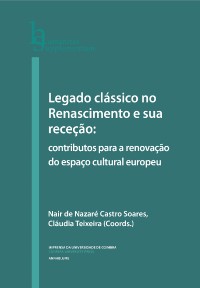Please use this identifier to cite or link to this item:
https://hdl.handle.net/10316.2/42977| DC Field | Value | Language |
|---|---|---|
| dc.contributor.author | López Moreda, Santiago | |
| dc.date.accessioned | 2017-10-04T14:27:26Z | |
| dc.date.accessioned | 2020-09-05T23:29:58Z | - |
| dc.date.available | 2017-10-04T14:27:26Z | |
| dc.date.available | 2020-09-05T23:29:58Z | - |
| dc.date.issued | 2017 | - |
| dc.identifier.isbn | 978-989-26-1292-8 | |
| dc.identifier.isbn | 978-989-26-1293-5 (PDF) | |
| dc.identifier.issn | 2182‑8814 | |
| dc.identifier.uri | https://hdl.handle.net/10316.2/42977 | - |
| dc.description.abstract | The arrival of Alarico’s troops in Rome marked the end of the Roman Empire, which had been regarded as the first European Union. After the fall of Roma, the Old Empire became part of the past, some sort of memories that pervaded Christian culture and which came to the forefront once again during the 8th century, when Pipino is appointed King of the Francs by Pope Zacarias and anointed by Pope Esteban II. His son Charlemagne was crowned by Pope Leo III, on Christmas day 800, as “The Emperor that governs the Roman Empire.” This was a mere illusion given that the dismemberment of Charlemagne’s Empire paved the way for a myriad of feudal states which Petrarch will try to unify by means of the restitution imperii and Emperor Charles V of Boheme. | eng |
| dc.description.abstract | Con la entrada en Roma de las tropas de Alarico, se ponía fin al Imperio Romano que había sido la primera unidad europea. Tras la caída de Roma, el viejo imperio fue solamente un recuerdo que perduraba en el colectivo cristiano y que recuperó su razón de ser en el siglo VIII, cuando Pipino es reconocido como rey de los francos por el papa Zacarías y ungido por el Papa Esteban II. Su hijo Carlomagno fue coronado por el papa León III, en la Navidad del año 800, como “Emperador que gobierna el Imperio romano”. Fue solo un espejismo, porque la desmembración del imperio carolingio dio pie a una serie de estados feudales que habrían de esperar la llegada de Petrarca para tratar de recuperar mediante el emperador Carlos IV de Bohemia la ansiada restitutio imperii. | por |
| dc.language.iso | spa | - |
| dc.publisher | Imprensa da Universidade de Coimbra | por |
| dc.relation.ispartof | http://hdl.handle.net/10316.2/42974 | por |
| dc.rights | open access | - |
| dc.subject | empire | eng |
| dc.subject | religious unity | eng |
| dc.subject | political unityt | eng |
| dc.subject | restitution | eng |
| dc.subject | letters | eng |
| dc.subject | nationalism | eng |
| dc.subject | imperio | por |
| dc.subject | unidad religiosa | por |
| dc.subject | unidad política | por |
| dc.subject | restitutio | por |
| dc.subject | cartas | por |
| dc.title | La restitutio imperii en las cartas de Petrarca al emperador Carlos IV | por |
| dc.title.alternative | The restitutio imperii in Petrarca’s letters to Emperor Charles IV | eng |
| dc.type | bookPart | por |
| uc.publication.firstPage | 59 | - |
| uc.publication.lastPage | 73 | - |
| uc.publication.location | Coimbra | por |
| dc.identifier.doi | 10.14195/978-989-26-1293-5_3 | - |
| uc.publication.digCollection | PB | por |
| uc.publication.orderno | 3 | - |
| uc.publication.area | Artes e Humanidades | por |
| uc.publication.bookTitle | Legado clássico no Renascimento e sua receção: contributos para a renovação do espaço cultural europeu | - |
| uc.publication.manifest | https://dl.uc.pt/json/iiif/10316.2/42977/202679/manifest?manifest=/json/iiif/10316.2/42977/202679/manifest | - |
| uc.publication.thumbnail | https://dl.uc.pt/retrieve/11043133 | - |
| uc.publication.parentItemId | 56847 | - |
| uc.itemId | 68545 | - |
| item.grantfulltext | open | - |
| item.fulltext | With Fulltext | - |
| Appears in Collections: | Legado clássico no Renascimento e sua receção: contributos para a renovação do espaço cultural europeu | |
Files in This Item:
| File | Description | Size | Format | |
|---|---|---|---|---|
| la_restitutio_imperii_en_las_cartas_de_petrarca.pdf | 920.43 kB | Adobe PDF |  |
Items in DSpace are protected by copyright, with all rights reserved, unless otherwise indicated.
